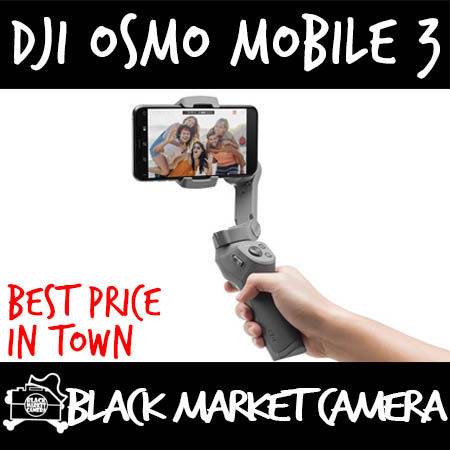Osmo Mobile 3
Osmo Mobile 3 Combo (With Mini Tripod & Case)
The DJI Osmo Mobile 3 smartphone gimbal carries over most of the features from the previous Osmo Mobile model with many improvements. It's lighter than its predecessor, it's now controlled with the DJI Mimo app for iOS or Android, it supports larger smartphones, features a new Sport mode, utilizes hand gesture control and body shape recognition, and it now supports Bluetooth 5.0. The handle has been redesigned so that the ports are all accessible when charging, it can fold down for storage, and the handheld experience has been made much more comfortable and accessible at a 15° angle.
You can mount any smartphone up to 3.5" wide in its phone cradle and capture smooth footage in handheld operation. The Osmo Mobile 3 syncs up with the DJI Mimo mobile app to provide you with multiple shooting modes and functions including Portrait, Underslung, Landscape, Time-Lapse, Panorama, and now a Sport mode for fast-action shooting. You can also now use hand gestures to control the gimbal to track your movement, take a selfie, or record video so you don't have to press the record button or touch any controls. It can also automatically track body shapes to track human subjects without the need to make a manual selection with ActiveTrack 3.0.
The built-in battery run-time is approximately 15 hours, and it takes approximately 2.5 hours to charge using the included USB Type-C cable. There is a USB Type-A power output on the back of the handle to charge your phone or other accessories while operating the gimbal. The bottom of the gimbal handle features a 1/4"-20 mounting thread to mount the gimbal on a tripod or other accessory. A storage pouch and wrist strap are also included with the gimbal. A storage pouch and wrist strap are also included with the gimbal.
Key Features
- Supports up to 3.5" wide smartphones
- Foldable design with redesigned ports, handle set at natural 15° angle
- Controllable range: -162.5 to 170.3° pan / -104.5 to 235.7° tilt / -85.1 to 252.2° roll
- Bluetooth 5.0 support
- Controllable speed: 120°/s max
- Built-in battery: Up to 15-hour run-time / 17.64Wh capacity, 2450mAh
- 1/4"-20 tripod mounting thread

Medium Format
Medium format refers to the size of your roll of film (or if you’re talking digital, it’s the size of the camera sensor). It really just means that you are shooting on a bigger piece of film than you do with a 35mm camera. The increased size of medium format film means a much larger negative. This will give you finer details and less grain.
Choosing your Right Medium Format Camera
Twin Lens Reflex (TLRS)
TLRs use two objective lens of the same focal length. The photographic objective lens is the one that is used to take the picture. The other lens, called the view lens, is connected to the viewfinder. Most TLRs are fixed focal length, and the more expensive models may incorporate a rudimentary room function. Most TLRs use a leaf shutter system, resulting in high speeds, quiet operation and low shutter vibration. There are also close-up, wide angle and telephoto adapters for TLRs.
Some popular TLRS cameras are: Yashica MAT-124G, Rolleiflex 2.8F, Minolta Autocord and Mamiya C330


Rangefinder
Rangefinder cameras are medium format cameras with a range finder. This negates the waistline, viewing that most TLRs carry. They are also much smaller than TLRs, and allow for easier point and shoot photographs. They tend to have limited focusing ranges, and do not have lenses larger than 180mm or 200mm. Rangefinders are quieter and easier to focus in dim light. They are mostly fixed lens models, but higher range models also provide for interchangeability.
Some popular rangefinder cameras are: Fujica G690, Mamiya 6/7, Bronica RF645, Norita 66 and Pentax 67
WhatsApp Only: +65-8223-7153

